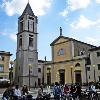The territory around Quarrata extends through the hills of Montalbano, a setting that the Medici family loved greatly and chose as their hunting grounds. Ferdinando II, in particular, was dedicated to creating the Barco Reale reserve in the 17th century, a wooded terrain enclosed by three kilometres of walls, crisscrossed by waterways and dotted with villas. Still today, this immense forest of oak trees is home to wild animals and rich vegetation.
The area of Quarrata is known for its artisan tradition, leading it to be known as the "city of furniture". This district produces various types of objects, such as framed and upholstered sofas, in classical and Renaissance style, and other furnishings.




















